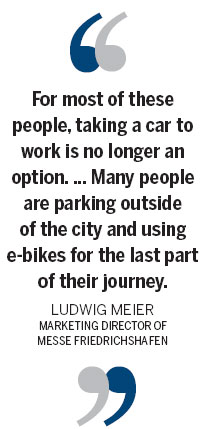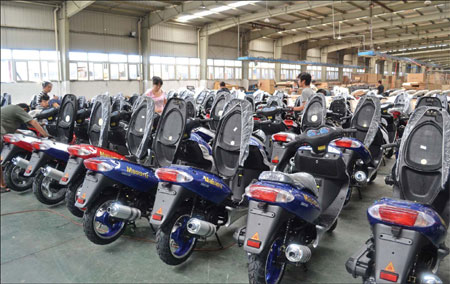Electric glide on easy street
Updated: 2012-08-17 11:12
By Todd Balazovic, Li Xinzhu and Cang Wei (China Daily)
|
|||||||||||
|
Some of the electric bikes produced at Chinese maker Jonway Group's plant are sold in the United States and Europe. Todd Balazovic / China Daily |
China's popular e-bikes are effortlessly rolling into europe, US
Stocked alongside crates of fresh fruit and canned vegetables in the side room of a family-owned grocer in Arizona, Sam Hom is selling an unlikely replacement for thrifty Americans looking for an auto alternative. The 78-year-old, Chinese-born American was the first to begin offering electric bicycles in his small community in the center of Arizona's capital, after converting half his grocer supply store, Phoenix Produce, into the city's only e-bike shop in 2006.
 |
The idea came to Hom during one of his annual visits to his birthplace of Kaiping in Guangdong province, southern China, from where he emigrated to the United States more than 50 years ago.
"Everywhere on the streets, people were riding electric bikes and I thought, why don't they do this in America?" he says.
"So I began talking to some businesses, and shortly after, shipped my first crate from China."
Using a lightweight electric motor, e-bikes allow users to switch between pedaling and electronic assistance, with an average battery range of 64 kilometers per charge, with no emissions and very little sound.
However, when Hom began importing from China more than five years ago, e-bikes were virtually unheard of in car-loving US - so much so that his wife Tracy opposed the idea.
"When he started doing this, I was really against it," she says. "I thought it was a liability for us and no one would buy them."
The skepticism was not unfounded. In his first year, he sold five. But now, Hom's business is booming and his yearly sales have increased to more than 120.
"You know, right now businesses in America are not doing so well. But Sam seems to be doing quite good," Tracy says.
With the price of one of his e-bikes at around $500 (407 euros), Hom's choice to go Chinese has given him a competitive edge over the European or US manufactured models selling for $1,300 or more - the price of a used car.
"The Chinese bikes are much cheaper, which is appealing to customers," Hom says.
| ||||
And, as the largest and oldest e-bike industry in the world, China is poised to make its mark on the industry.
As the first nation to embrace the e-bike for everyday use, China is the largest market with 30 million sold annually and more than 125 million on the streets.
Here, they've taken on a multitude of roles, from family vehicle, transporting mother, father and child across town for a day in the park, to a delivery vehicle for the millions of dollars worth of online purchases delivered daily throughout the largest online shopping nation.
In the US, the numbers are significantly smaller with just 80,000 sold biannually, according to the Electric Bikes Worldwide Report, published annually in the US.
Europe, with a more robust cycling culture, is somewhat higher with 1.2 million bikes sold in a year.
But those numbers are expected to rise, with 150,000 annual sales expected in the US and more than 2 million in the EU by 2014 as more people turn to cycling as car commutes become increasingly troublesome.
"For most of these people, taking a car to work is no longer an option," says Ludwig Meier, marketing director for Messe Friedrichshafen, co-organizer of the Eurobike Show, the world's largest bike tradeshow.
"Fuel costs aside, heavy traffic and a lack of parking spaces in downtown areas make the last leg of a car commute the most difficult. So, many people are parking outside of the city and using e-bikes for the last part of their journey," he says.
Meier, who visited China for the second annual Asiabike 2012 expo in Nanjing in late July, says consumers find e-bikes a better option than traditional bicycles because of the little exertion required.
"It would probably not look good for a banker or businessman to show up to work covered in sweat," he says.
With fuel prices in the US and Europe climbing steadily upward, it also saves money.
But it's not just commuters taking to the powered pedals.
In addition to those looking for an environmentally friendly way to conduct day-to-day chores, the bikes have also hit a note with elderly riders, who use the power assistance to overcome steep hills and rough terrain.
"The people now buying e-bikes in Europe and the US fall into two classes - those who are focused only on the price of the bikes and those going after quality and style," Meier says.
Similar to electric scooters, which are growing in popularity, e-bikes in the US are limited to speeds of 15 miles per hour and in the EU to 25 kilometers an hour.
Though regulations vary from state to state and from country to country, the limited power and speed of the bikes allow them to be classified as non-motor vehicles, often requiring no license or registration.
China's early edge in the e-bike industry is due in large part to the government setting the sector's development as one of official technology goals in 1991. Chinese companies discovered new ways to create cheap, effective components, and the technology took off.
Between 1991 and 2001, annual sales in China went from 100,000 to a million, and have been climbing at a faster rate since. Cashing in on the demand, more than 2,500 Chinese companies were manufacturing e-bikes by 2006.
One of the oldest companies, Jonway Group, established in 1986, is among scores of companies now pursuing Western clients as it pushes to establish its brand early in the market.
Its main factory, housed among dozens of other e-vehicle manufacturing plants in the small coastal city of Taizhou in Zhejiang province, where a large portion of China's electric bikes and scooters are made, churns out hundreds of electric vehicles daily.
Of the 50,000 vehicles it will produce this year, 10 percent will be sold in Europe and the US, says Liang Yulin, sales manager at Jonway Group's electric vehicle division.
Europe takes up most of its overseas sales, he says, but as the US shows more interest, he expects exports to grow quickly due to the relatively easier export regulations there.
"In Europe we must have an EUC (End User Certificate). Every one of our models must meet the standards outlined there," Liang says.
"The biggest difference between Europe and the US, is that in Europe you must have this certificate. But in the US there is no such certificate required."
Instead, the vehicles must be registered with the US Department of Transportation, he says.
While many of its products are sold overseas, Jonway is probably not a brand name many Western riders will recognize.
With most overseas exports, the receiving company buys the Chinese-made bikes or components and re-brand them as its own, marking up the price along the way, Liang says.
While Chinese e-bikes are cheap - on the streets of Beijing one can be purchased for around 1,400 yuan ($220, 180 euros) - the low price tag does not always attract interest from retailers. In Europe, the relative success of the industry is due to the popularity of luxury design e-bikes, selling for upward of 3,000 euros.
"The thing in Europe that's happened is bike shops have discovered they can make a lot more money selling electric bikes because they're higher price-point," says Frank Jamerson, author of the Electric Bikes Worldwide Report and a former General Motor Co employee involved with the development of the automaker's first electric car, the EV1.
"So they're promoting them very strongly, and the market is therefore accepting it."
Seeing the potential of this new trend, luxury car manufacturers such as Audi, BMW and Smart have released their own versions of futuristic-looking electronic bikes in the past two years.
While in China the e-bikes are generally marketed as a cheap alternative to automobiles, the overseas market potential for high-end electric models has not gone unnoticed.
At the second annual Asiabike expo in Nanjing, e-bike maker Citybug displayed a stylish new white and green framed electronic bike to crowds of eager onlookers. With price tags starting at 5,000 yuan, the bikes are selling at several times what the average Chinese consumer would pay. But its factories in Dongguan and Shenzhen are not targeting Chinese, says Citybug's sales representative He Rui.
Designed and priced to appeal to "emerging e-bike markets", she says 80 percent of sales go to Germany, with the rest mostly to other parts of Europe. "Right now we don't sell any in the US, but we want to eventually," He says.
But for Chinese manufacturers in the US, price continues to be paramount.
Taking advantage of China's low manufacturing costs, Chinese brand Taotao is adopting a more direct approach to selling in America.
Earlier this year, the Taizhou-based company opened its sixth North American distribution center in Indianapolis, Indiana, cutting out expensive import-export services and offering its electric vehicles at one of the lowest costs in the US market.
But regardless of price, consumers should pay attention to the true value of e-bikes, both economic and ecological, Jamerson says.
"People need to focus on the value. Compared to a $30,000 car or a $40,000 electric vehicle, for short trips these just cost pennies to run."
Contact the writers through toddbalazovic@chinadaily.com.cn
(China Daily 08/17/2012 page12)
Today's Top News
Rescuers race against time for quake victims
Telecom workers restore links
Coal mine blast kills 18 in Jilin
Intl scholarship puts China on the map
More bird flu patients discharged
Gold loses sheen, but still a safe bet
US 'turns blind eye to human rights'
Telecom workers restore links
Hot Topics
Lunar probe , China growth forecasts, Emission rules get tougher, China seen through 'colored lens', International board,
Editor's Picks

|

|

|

|

|

|








